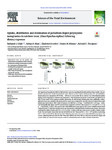Uptake, distribution and elimination of palladium-doped polystyrene nanoplastics in rainbow trout (Oncorhynchus mykiss) following dietary exposure
| dc.contributor.author | Clark, Nathaniel | |
| dc.contributor.author | Khan, FR | |
| dc.contributor.author | Crowther, C | |
| dc.contributor.author | Mitrano, DM | |
| dc.contributor.author | Thompson, Richard | |
| dc.date.accessioned | 2022-10-28T12:21:55Z | |
| dc.date.issued | 2023-01-01 | |
| dc.identifier.issn | 1879-1026 | |
| dc.identifier.issn | 1879-1026 | |
| dc.identifier.other | 158765 | |
| dc.identifier.uri | http://hdl.handle.net/10026.1/19775 | |
| dc.description.abstract |
The ingestion of nanoplastics (NPs) by fish has led to concerns regarding fish health and food chain transfer, but analytical constraints have hindered quantitative data collection on their uptake and depuration. We used palladium-doped polystyrene nanoplastics (PS-Pd NPs, ~200 nm) to track particle fate in rainbow trout (Oncorhynchus mykiss) during a week-long dietary exposure and subsequent 7-day depuration period on a control diet (no added PS-Pd NPs). At Day 3 and 7 of the exposure, and after depuration, the mid intestine, hind intestine, liver, gallbladder, kidney, gill and carcass were sampled. All organs and the carcass were analysed for total Pd content by inductively couple plasma mass spectrometry. After 3 days of exposure, the mid (32.5 ± 8.3 ng g-1) and hind (42.3 ± 8.2 ng g-1) intestine had significantly higher total Pd concentrations compared to the liver and carcass (1.3 ± 0.4 and 3.4 ± 1.1 ng g-1, respectively). At Day 7, there was no time-related difference in any organ (or the carcass) total Pd concentrations compared to Day 3. When the total Pd content was expressed as a body distribution based on mass of tissue, the carcass contained the highest fraction with 72.5 ± 5.2 % at Day 7, which could raise concerns over transfer to higher trophic levels. The total number of particles that entered the fish over the 7 days was 94.5 ± 13.5 × 106 particles, representing 0.07 ± 0.01 % of the Pd the fish had been fed. Following depuration, there was no detectable Pd in any organ or the carcass, indicating clearance from the fish. These data indicate that these NPs are taken into the internal organs and carcass of fish, yet removal of the exposure results in substantial excretion to below the limit of detection. | |
| dc.format.extent | 158765-158765 | |
| dc.format.medium | Print-Electronic | |
| dc.language | en | |
| dc.language.iso | eng | |
| dc.publisher | Elsevier | |
| dc.subject | Nanoplastic | |
| dc.subject | Gastrointestinal tract | |
| dc.subject | Exposure | |
| dc.subject | Accumulation | |
| dc.subject | Depuration | |
| dc.title | Uptake, distribution and elimination of palladium-doped polystyrene nanoplastics in rainbow trout (Oncorhynchus mykiss) following dietary exposure | |
| dc.type | journal-article | |
| dc.type | Journal Article | |
| plymouth.author-url | https://www.webofscience.com/api/gateway?GWVersion=2&SrcApp=PARTNER_APP&SrcAuth=LinksAMR&KeyUT=WOS:000877216600006&DestLinkType=FullRecord&DestApp=ALL_WOS&UsrCustomerID=11bb513d99f797142bcfeffcc58ea008 | |
| plymouth.volume | 854 | |
| plymouth.publication-status | Published | |
| plymouth.journal | Science of the Total Environment | |
| dc.identifier.doi | 10.1016/j.scitotenv.2022.158765 | |
| plymouth.organisational-group | /Plymouth | |
| plymouth.organisational-group | /Plymouth/Faculty of Health | |
| plymouth.organisational-group | /Plymouth/Faculty of Health/School of Health Professions | |
| plymouth.organisational-group | /Plymouth/Faculty of Science and Engineering | |
| plymouth.organisational-group | /Plymouth/Faculty of Science and Engineering/School of Biological and Marine Sciences | |
| plymouth.organisational-group | /Plymouth/REF 2021 Researchers by UoA | |
| plymouth.organisational-group | /Plymouth/REF 2021 Researchers by UoA/UoA07 Earth Systems and Environmental Sciences | |
| plymouth.organisational-group | /Plymouth/Research Groups | |
| plymouth.organisational-group | /Plymouth/Research Groups/Marine Institute | |
| plymouth.organisational-group | /Plymouth/Users by role | |
| plymouth.organisational-group | /Plymouth/Users by role/Academics | |
| plymouth.organisational-group | /Plymouth/Users by role/Researchers in ResearchFish submission | |
| dc.publisher.place | Netherlands | |
| dcterms.dateAccepted | 2022-09-10 | |
| dc.rights.embargodate | 2022-10-29 | |
| dc.identifier.eissn | 1879-1026 | |
| dc.rights.embargoperiod | Not known | |
| rioxxterms.funder | Natural Environment Research Council | |
| rioxxterms.identifier.project | Current and Future Effects of Microplastics on Marine Shelf Ecosystems (MINIMISE) | |
| rioxxterms.versionofrecord | 10.1016/j.scitotenv.2022.158765 | |
| rioxxterms.licenseref.uri | http://www.rioxx.net/licenses/all-rights-reserved | |
| rioxxterms.licenseref.startdate | 2022-09-14 | |
| rioxxterms.type | Journal Article/Review | |
| plymouth.funder | Current and Future Effects of Microplastics on Marine Shelf Ecosystems (MINIMISE)::Natural Environment Research Council |


